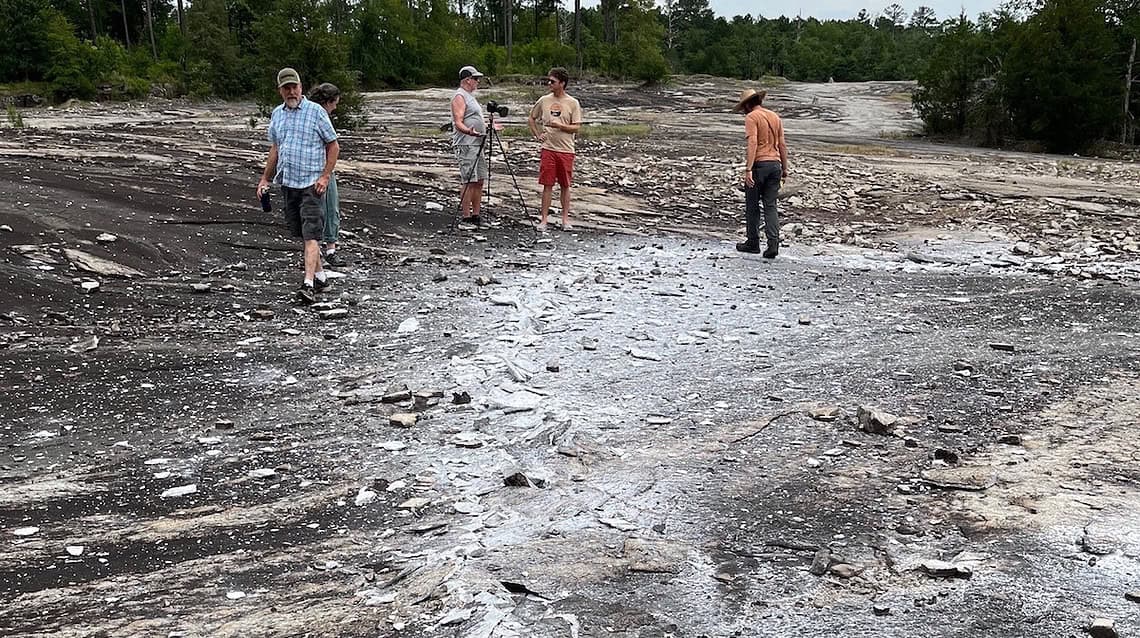Did An Earthquake Strike Arabia Mountain?

On Monday, July 17, a mysterious geological event occurred at Arabia Mountain that left large cracks in the outcrop.
Was that an earthquake that struck Arabia Mountain earlier this week? At around noon on Monday, July 17, multiple visitors to the Davidson-Arabia Mountain Nature Preserve’s (DAMNP) reported feeling the earth move and hearing what sounded like a blast or explosion. When a regular hiker to the preserve told Ranger Doffice at the Nature Center that the outcrop near the Mile Rock Trail was “moving up around him,” DAMNP staff had to investigate.
A Crack In The Outcrop
Preserve Manager Robby Astrove reached out to Arabia Alliance staff and Alan Cressler of the United States Geological Survey (USGS) to join the investigation. On Wednesday July 19, on the northwestern side of Arabia Mountain along Mile Rock Trail, the three teams found a strange scene: a large semi-circular stretch of Lithonia Gneiss (the name of the metamorphic rock that makes up this outcrop) split open along with a bevy of fresh fragments and rock chunks that looked as if they’d been spewed into the air. Bits of debris spread out over a football-field-sized area. New fissures in the outcrop were covered in a fine, sugar-white rock dust where the broken plates of rock had ground against each other. Whatever happened had been explosive. But how did it happen?

A fresh fault in the outcrop.
“I’ve been out here a dozen years and I’ve never seen anything quite like this or on this scale,” said Astrove, nodding his head, excited by the discovery. “I’ve definitely seen cracks, but the assumption was that when they quarried [decades ago] the aftershocks from that created those.”
Equally impressed, Cressler meticulously photographed the new cracks in the ancient mountain’s hard surface. A DeKalb County native, Cressler has been visiting Arabia Mountain since childhood and has a rare, decades-old knowledge of the place. He’s also been working for the USGS thirty-six years. On the verge of retirement, he echoed Astrove’s sentiments. “I’ve not seen this before, but there are some examples or similar upheavals,” said Cressler. “To the east, there’s a formation I call ‘Arabia natural bridge’ because it’s anchored at both ends. I was wondering how that formed: well, now I have some ideas.”

An example of an upheaval or smaller “natural bridge” just formed at the mountain.
Mystery On The Monadnock
Arabia Mountain might look frozen in time but it’s still undergoing changes. Fresh cracks in the outcrop, which can break off almost like sharp layers of a rocky onion, are part of the natural weathering process of the landscape called exfoliation. How it happens is not fully understood but it could have been a small tremor or earthquake.
Visitors recorded feeling the Monday morning shock at the Arabia Mountain Nature Center about a half-mile away. “We’re in touch with the people who run the seismograph at Georgia Tech to see if it got picked up,” said Astrove about the possibility of a small, localized earthquake. “It sounds like a big deal to us, but it’s possible this was just another little hiccup. And depending on how sensitive the machines are, they might get something or they might not.”
While a seismic event might seem unlikely, it’s not impossible. A number of fault lines travel through Georgia, including the Brevard Fault, which runs from Marietta up to the Blue Ridge Mountains. Ancient seismic activity originally created Arabia, Panola and Stone Mountains. All three are geological formations known as monadnocks. Millions of years ago, these solid rock masses were massive underground pockets of magma. Instead of rupturing through the surface as a volcano, these subterranean lava lakes cooled and hardened into solid rock masses (or monadnocks) that millions of years of erosion exposed to the surface.
A Changing Mountain
Over time, the unique environment at Arabia Mountain continues to reveal itself. “When I see stuff like this, I think, ‘When did that happen?'” said Astrove. “Now we can come back and say, ‘We know when this happened.'”
Arabia Alliance Executive Director Revonda Cosby found a wing-shaped chunk of the newly broken rock. It’s a perfect example of the signature Arabia Tidal Grey metamorphic gneiss that was so desirable for more than a century. “It’s beautiful,” said Cosby. “It looks like a bird taking flight.”

ED Revonda Cosby holding a new chunk of Lithonia Gneiss from the mountain.